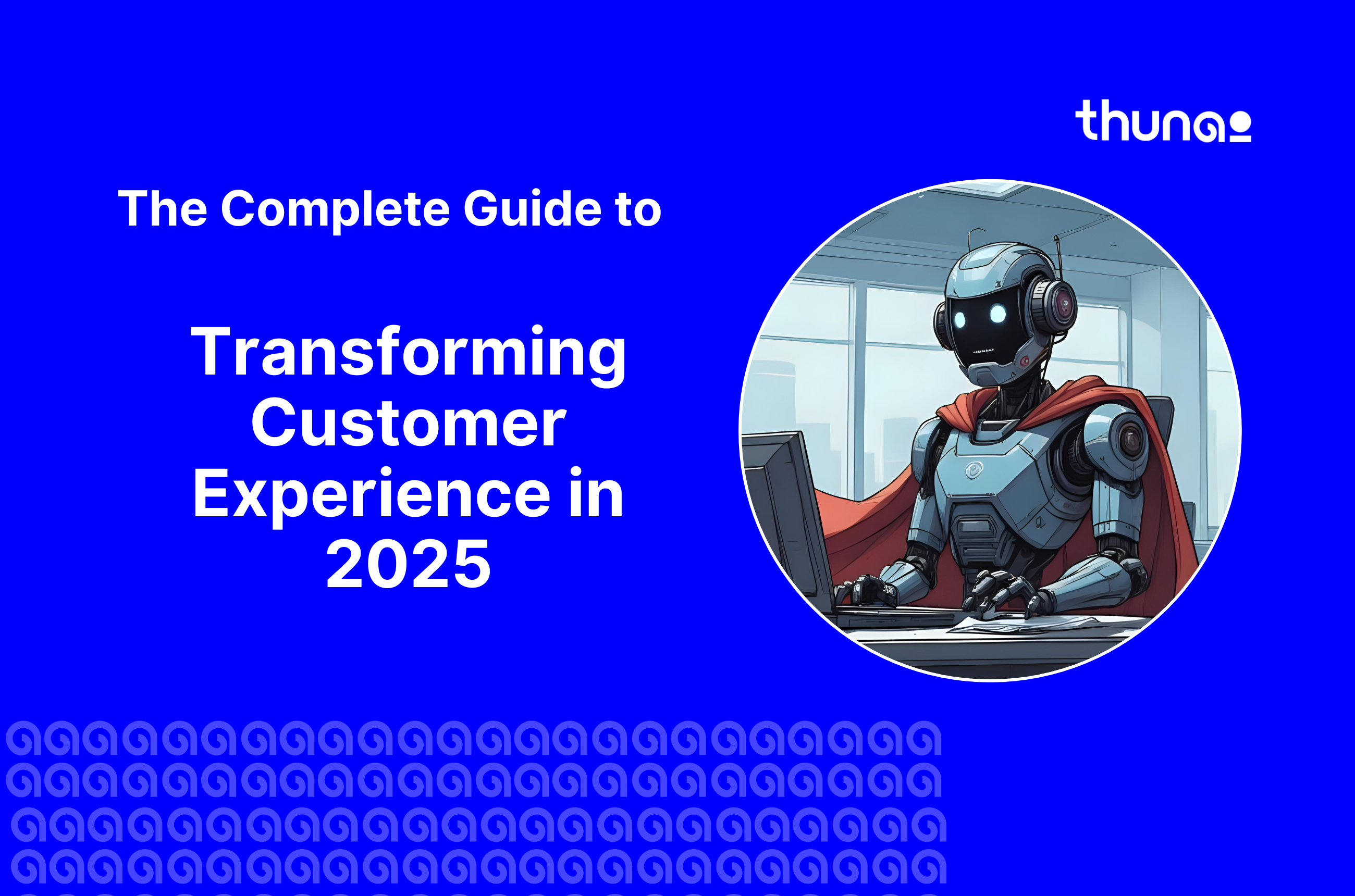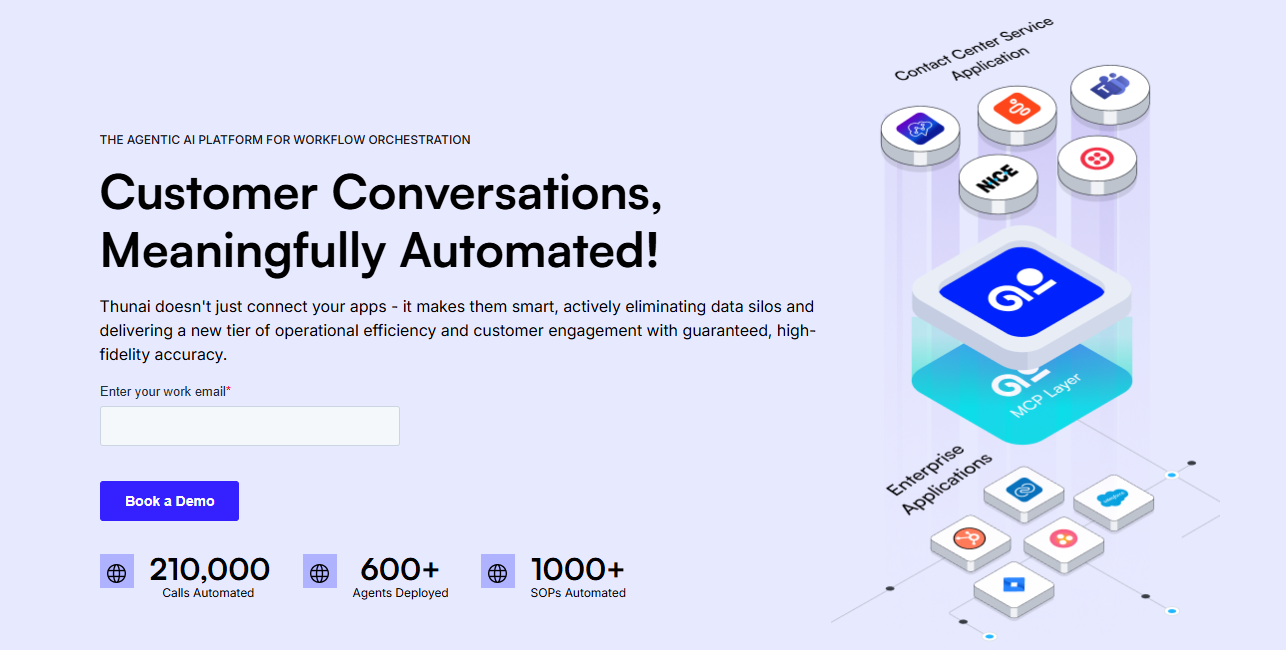AI in Customer Service: The Complete Guide to Transforming Customer Experience in 2025



Thunai learns, listens, communicates, and automates workflows for your revenue generation team - Sales, Marketing and Customer Success.
TL;DR
Summary
- AI in customer service has advanced far beyond chatbots, evolving into a multi-layered system for automation, personalization, and direct action.
- Rather than replacing agents, AI handles repetitive tasks to reduce burnout and lets human teams focus on complex, high-value interactions that strengthen customer relationships.
- The key success factor is maintaining a high-quality, accurate knowledge base — poor data leads to poor AI performance and wasted investment.
Are your customers tired of repeating themselves every time they switch channels?
The reality is that you need faster resolutions and happier agents. You also need a support function that actively brings in revenue, not just costs.
That’s why AI in customer service has turned into a planned necessity for 2025. This guide will show you how the technology works…
What is AI in Customer Service?
The meaning of AI in Customer Service has moved on from its early association with simple chatbots. The term now describes a complete and deeply connected intelligent system. This is a planned layer of intelligence built into a company's customer operations.
This system is made up of advanced technologies that include machine learning, natural language processing, predictive analytics, and generative AI. They all work together to come up with smooth and empathetic conversations.
The main purpose has changed a lot. The goal is no longer just about automation or deflecting simple questions. The new goal is to set up interactions that are more personalized, productive, and emotionally intelligent.

How is AI Used in Customer Service?
The use of AI in customer service in 2025 is a multi-layered structure. Each layer builds upon the last. This creates an increasingly advanced support system. These can be understood as the Automation, Intelligence, and Action layers.
1. The Automation Layer: The Foundation of Productivity
- This foundational layer is the main work component of the AI in customer service model. The layer is set up to give out instant, 24/7 support for high-volume, repetitive questions.
- These include questions like: Where is my order? How do I reset my password? Or what is your refund policy? By automating these interactions, businesses achieve major productivity gains. Some see a 60-80% drop in their total support ticket volume.
- This layer also includes intelligent routing. Here, AI in customer service analyzes an incoming query's intent and sentiment. The system then sends the query on to the best-suited human agent.
- This practice for AI in customer service has been shown to increase agent productivity by 33%.
2. The Intelligence Layer: Driving Personalization and Proactivity
Building on automation, the intelligence layer uses AI's analytical ability to get to know the customer on a deeper level.
This is where hyper-personalization happens. AI algorithms look into a customer's browsing behavior, purchase history, and even inferred intent. AI in customer service then uses this information to put together uniquely customized experiences.
- This directly affects the bottom line. Projections show hyper-personalization can generate up to 40% more revenue. This layer also uses real-time sentiment analysis on text and voice.
- This helps to detect a customer's emotional state, such as frustration, satisfaction, or confusion. The system then adapts its responses or alerts a human agent for a more empathetic interaction.
3. The Action Layer: The Rise of Agentic AI
This layer for AI in customer service represents the most significant development for 2025. This is the domain of Agentic AI. Here, autonomous systems are given the ability to carry out direct, decisive action on a customer's behalf.
This marks a very important shift. The model moves on from an instructional one, like saying here is how you can request a refund. The new model is an executory one, like saying your refund has been processed. By 2025, AI agents can perform complex, multi-step tasks directly within a conversation, such as:
- Initiating a refund, generating a shipping label, or canceling a subscription.
- Looking up and updating live data from a CRM or order management system.
- Booking appointments by connecting directly with scheduling tools.
AI-Powered Chatbots and Virtual Assistants
Thinking of chatbots as a bad experience, meaning cold, robotic, and ineffective, is an old idea from a previous technological era.
The modern conversational AI landscape has been changed by huge steps forward in Large Language Models (LLMs) like Anthropic's Claude 3.5 and Google's Gemini 2.0.
AI in customer service can now engage in fluid, context-rich conversations and call up a customer's history for a truly personalized experience.
The market for these platforms is dynamic. Picking out the right ai in customer service means you have to look past marketing claims to real-world user feedback shared in forums like Reddit.
- Top-Tier Enterprise Platforms (e.g., Intercom, Zendesk): They are praised for solid features and deep connections with other systems. But a persistent theme in user forums is their high cost. This can turn into a major financial burden as a business grows.
- E-commerce Specialists (e.g., Gorgias, Tidio): These are valued for deep connections with platforms like Shopify. Tidio's Lyro AI agent is frequently recommended as a good, affordable solution for small to medium-sized online businesses.
- Flexible and Developer-Centric Options (e.g., YourGPT, Chatbase): YourGPT is lauded in user communities for its flexibility and ability to carry out multi-step actions. Chatbase is seen as excellent for simple bots but too limited for complex workflows.
Voice AI Agents - Top 7 Picks to Look at in 2025
For years, automated phone support was defined by frustrating IVR systems. These systems made users press 1 for sales or press 2 for support. In 2025, voice is making a strong comeback.
This is a result of advanced AI that swaps out clunky menus for fluid, conversational interfaces. These interfaces can understand complex intent and human-like dialogue. Here are the top AI voice agents that you should look at in 2025:

- Thunai AI: Thunai provides human-like AI voice agents equipped with screen sharing to resolve customer and employee issues more quickly. These AI customer service agents can see a user's screen in real-time and provide step-by-step verbal guidance to solve problems in over 150+ languages.
- Lindy: An all-in-one, no-code platform ideal for teams needing to put together a fully functional voice agent for sales or support without coding.
- Vapi: An API-first platform for developers who need deep customization. The platform has very low latency for conversations that feel instantaneous.
- ElevenLabs: A best-in-class voice generator. This system creates very realistic and emotionally rich voices. This makes it perfect for giving a premium, human-sounding voice to an agent built on another platform.
- Synthflow: A no-code builder designed for speed. The AI customer service automation tool lets non-technical teams set up agents for tasks like appointment booking in under an hour.
- Retell AI: Made for support and sales teams with a strong attention to post-call processes. The platform is great at turning conversations into structured data and call summaries for CRMs.
- Cognigy: An enterprise-grade platform built for the complexities of large contact centers. It is especially useful in regulated industries like banking and healthcare.
- Hume AI: A research-based leader in emotionally intelligent conversations. This makes it the best choice for situations where empathy and emotional connection are most important.
AI in Customer Service Automation: Key Applications
1. Automated Ticket Management
AI in customer service automation is changing the helpdesk from a manual, queue-based system. AI in customer support is turning into an intelligent, automated workflow engine. Using NLP, AI systems instantly analyze incoming tickets. They carry out very important tasks that were once handled manually:
- Classification and Triage: The system identifies the request's main intent. Using AI in customer service also helps detect the customer's sentiment and assess its urgency.
- Prioritization and Routing: Based on the analysis, the ticket is prioritized. The system then automatically routes the ticket to the best-suited agent with the specific skills to handle it. This gets around a human dispatcher.
- Agent Augmentation: When the ticket lands in an agent's queue, using AI in customer service allows for an instant summary of the issue. The AI also suggests relevant replies based on past resolutions of similar issues.
2. Knowledge Base Connection
The single most important factor for success for any AI customer service setup is the quality of its underlying knowledge base (KB). The KB stands for the central source of information for the entire system.
A poorly maintained, inaccurate, or incomplete KB will certainly bring about a poorly performing AI tool in customer support. When done right, the KB becomes a dynamic, intelligent hub that supports the entire system.
- Supporting Customer Self-Service: An AI-supported KB lets customers ask questions in natural language. AI in customer support then get back precise answers. This satisfies 61% of customers who would rather find answers on their own for simple issues.
- Assisting Agent Assistance (Co-pilot): During a live interaction, the AI in customer support can listen in on the conversation. The AI can then automatically bring up the most relevant KB articles or policy documents on the agent's screen.
- Guiding Content Strategy: By looking into the questions that customers ask but for which it cannot find answers, the AI automatically identifies content gaps in the knowledge base. The system can then alert content teams about what needs to be created or updated.
This shows a very important planned sequence. A successful AI plan must be preceded by a solid knowledge management plan.
3. Multi-Channel Support
Customers expect a smooth and consistent experience. This is true whether they are using live chat, sending an email, or messaging on WhatsApp. AI in customer support is the technology that makes a true omnichannel plan possible.
- AI in customer support’s primary function is to break down the silos between communication channels. The system does this by bringing together all interactions into a single, unified customer view in a CRM. This gives agents a 360-degree view of the customer.
- The process gets rid of one of the biggest points of customer frustration. This frustration is having to repeat their issue every time they switch channels.
- This consistency is very important for meeting modern service expectations. This is especially true on social media, where 42% of customers now expect a response within 60 minutes.
Benefits of AI in Customer Service
Using AI in customer support brings about a strong, varied return on investment. These benefits of AI in customer service are seen across finance, operations, customer satisfaction, and employee engagement.
Operational and Financial Impact
The business case for the benefits of AI in customer service, based on data, is clear and compelling.
| Area | Improvement Seen |
|---|---|
| Cost Decrease | 35% decrease in overall customer service expenses |
| Productivity Gains | 52% faster ticket resolution time |
| Revenue Effect | Up to 40% more revenue from hyper-personalized experiences |
| Productivity Increase | 94% of specialists report increased productivity with conversational AI |
Improving the Customer Experience (CX)
- AI lines up service delivery with the main consumer demands of speed, convenience, and personalization.
- A recent study found that 51% of consumers expect businesses to be available around the clock. The benefits of AI in customer service make this a cost-effective reality.
- Furthermore, a McKinsey report found that 71% of customers now expect companies to give personalized interactions. They become frustrated when they do not get them. This level of personalization is only possible with AI.
Assisting the Human Agent: ROI With Thunai AI
Perhaps the most profound, yet often underestimated, benefit of AI is its positive effect on human agents.
By automating the bulk of monotonous, repetitive inquiries, the benefits of AI in customer service help directly deal with the main cause of agent burnout.
An investment in a tool like Thunai is therefore not just an automation plan. It is a human capital plan that builds up the ability of the entire support department, leading to a more skilled, satisfied, and stable team
- This leads to what one report described as simply happier agents. A HubSpot survey found that 71% of customer service specialists report that one of the benefits of AI in customer service is that it increases the time they spend on enjoyable work duties.
- An investment in AI is therefore not just an automation plan. This is a human capital plan that builds up the ability of the entire support department.
Want to see Thunai in action? Book a free demo!
FAQs on AI in Customer Service
How do we get started with AI, and what is a realistic setup plan?
Begin with small pilot programs in high-volume areas like FAQs to demonstrate value quickly. Train the AI on your specific business knowledge and connect it to your main systems like your CRM. Continuously monitor the AI's performance and refine it over time, always ensuring customers can easily reach a human agent if needed.
What are the biggest challenges and risks we need to manage?
The main challenges are often internal, such as disorganized data and older IT systems that are difficult to connect with. It is important to balance automation with a human touch, as many customers still prefer a live person for complex problems. You must also carefully manage data privacy and prevent AI inaccuracies by limiting the AI to your company's verified information
Will AI replace our human customer service agents?
No, the general agreement is that AI will not replace human agents but will instead change their role significantly. AI will take over routine tasks, which frees up human agents to focus on more complex problems and build stronger customer relationships. This change requires companies to invest in training programs to upskill their employees for these more advanced responsibilities.







